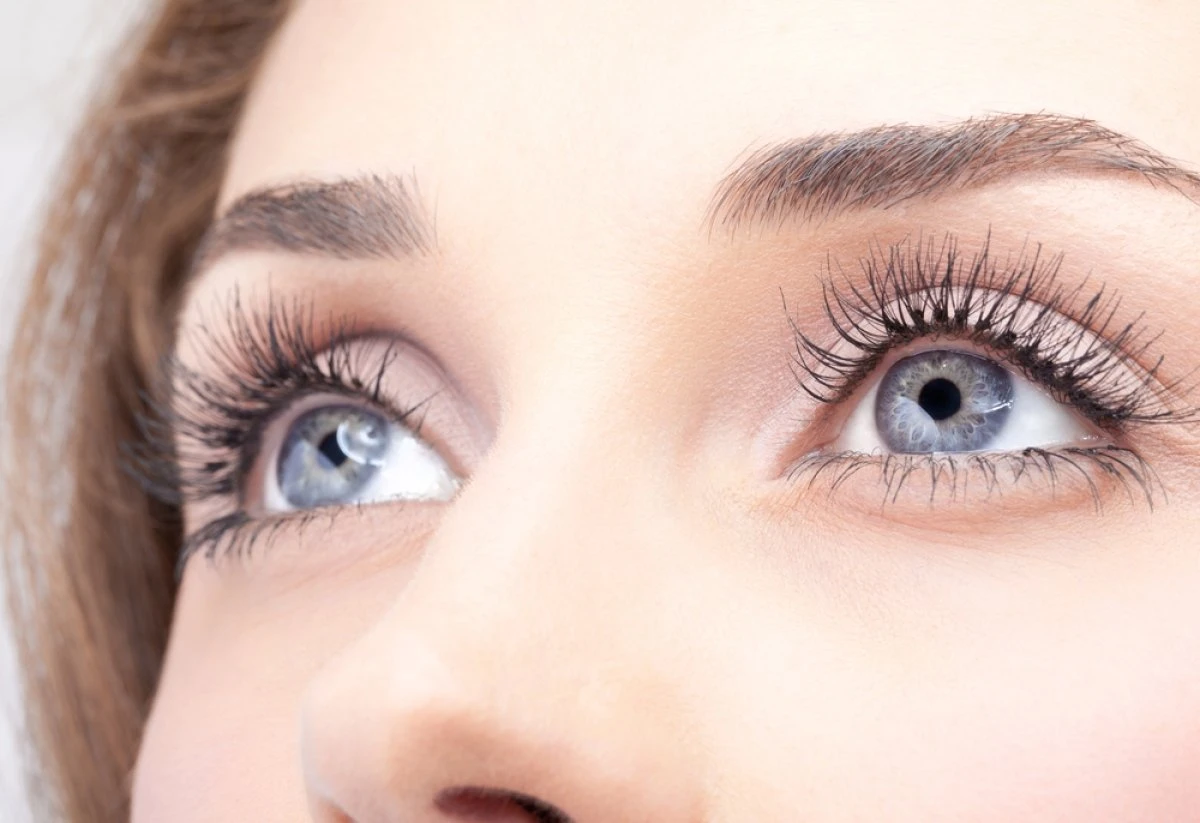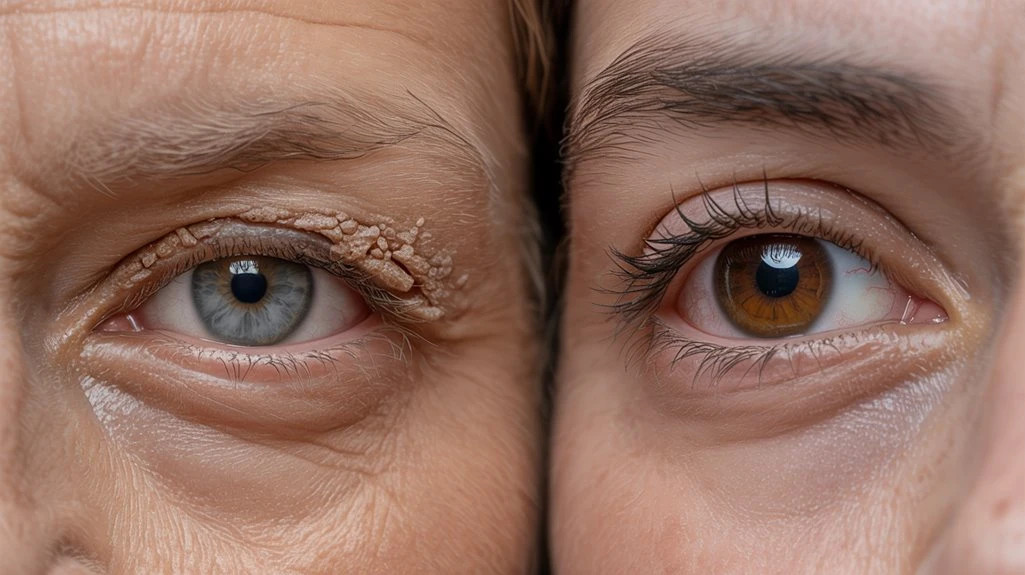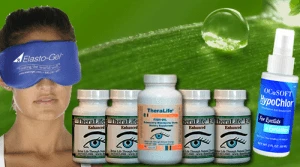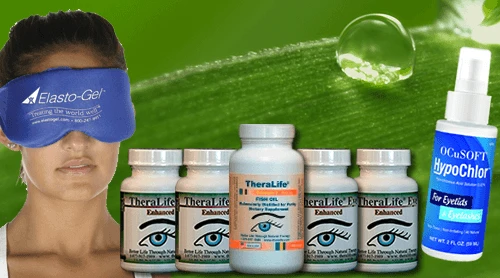TheraLife offers a unique approach to eye care by providing oral treatment options that effectively target conditions like blepharitis, styes, and other eye-related concerns. Unlike other companies, TheraLife is the only provider of oral eye treatment care, ensuring comprehensive relief and long-term benefits. By focusing on internal healing, TheraLife’s products help reduce symptoms such as chronic redness, scaling, and lash changes associated with blepharitis, while also addressing the sudden, painful bumps caused by styes. Customers can confidently identify and treat these conditions with TheraLife’s innovative solutions, which also respond well to warm compresses and lifestyle modifications.
Best Blepharitis Treatment From TheraLife
Key Takeaways
- Blepharitis causes diffuse redness and crusting along the entire eyelid margin, while a stye appears as a single, painful, red bump.
- Styes present with acute, localized pain and swelling, but blepharitis causes chronic irritation, burning, and flaky skin.
- Blepharitis typically affects both eyelids, whereas a stye is confined to one spot at the lash line or eyelid gland.
- Styes often produce thick, purulent discharge, while blepharitis leads to greasy, flaky, or crusty secretions without pus.
- Blepharitis requires ongoing eyelid hygiene for control, but styes generally resolve quickly with warm compresses or minor interventions.
Location of the Problem
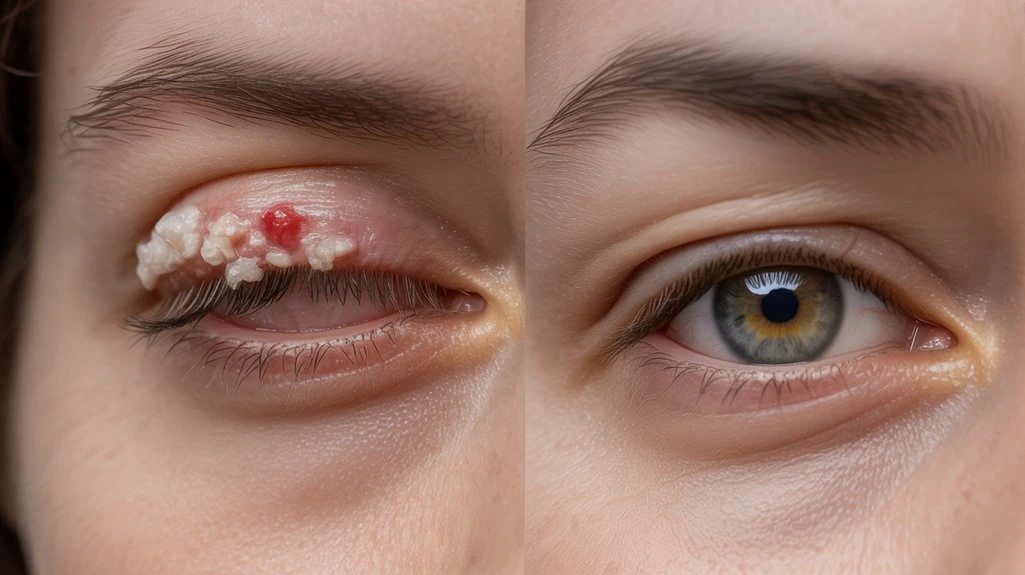
Blepharitis typically affects the entire eyelid margin, involving both the upper and lower lids, whereas a stye (hordeolum) is localized to a specific area, most often at the base of an eyelash or within a meibomian gland.
When you assess the location of the problem, you’ll notice blepharitis presents as diffuse inflammation, with eyelid sensitivity distributed along the whole lid margin. In contrast, a stye manifests as a focal, tender nodule, and eyelid sensitivity is concentrated at the lesion site.
Blepharitis often causes generalized itchiness levels across both lids, while a stye produces localized discomfort and less widespread itchiness.
Identifying whether the condition is diffuse or focal is vital for accurate diagnosis and differentiating between these two common eyelid disorders. Posterior blepharitis can lead to dry eyes due to dysfunction of the oil-secreting glands, further complicating the condition.
Appearance of the Eyelid
You’ll notice distinct patterns in eyelid redness and swelling when comparing blepharitis and stye.
Blepharitis typically presents with diffuse erythema and edema along the lid margins, while a stye appears as a localized, tender, erythematous nodule.
Recognizing these lesion location differences is essential for accurate diagnosis. It is important to understand that blepharitis symptoms can also include flaky skin around the eyes and a burning sensation, which are not commonly associated with a stye.
Redness and Swelling Patterns
Although both conditions involve eyelid inflammation, their redness and swelling patterns differ in diagnostic significance.
In blepharitis, you’ll typically observe diffuse erythema and mild, chronic swelling along the entire eyelid margin. This pattern reflects the underlying causal factors—chronic inflammation often linked with bacterial colonization, seborrheic dermatitis, or meibomian gland dysfunction. The redness appears less intense and persists over time, often responding to treatment options such as lid hygiene, topical antibiotics, or anti-inflammatory agents.
In contrast, a stye presents as localized, acute erythema and pronounced swelling confined to a small area of the eyelid. The redness is usually more vivid and centered around a tender nodule. This rapid-onset inflammation is commonly due to a bacterial infection, and treatment options primarily include warm compresses and, occasionally, antibiotics. Regular warm compress use is also recommended for chalazion management, helping to promote healing and reduce inflammation.
Lesion Location Differences
Lesion location serves as a critical diagnostic clue when differentiating between blepharitis and a stye.
In blepharitis, lesion types typically involve diffuse inflammation along the entire eyelid margin, affecting multiple follicles and glands. You’ll observe redness, scaling, and crusting distributed symmetrically at the base of the eyelashes. Lesion symptoms here are often bilateral, with chronic irritation and burning sensations.
In contrast, a stye presents as a localized, tender nodule. Styes most commonly develop at the eyelid margin or just inside it, corresponding to the infected gland (external stye for glands of Zeis or Moll, internal for meibomian). These lesion types are usually unilateral and acute, with focal swelling, erythema, and pain. Recognizing these lesion location differences streamlines your diagnostic process.
Additionally, warm compresses are effective for both chalazions and styes to promote drainage, as they help reduce inflammation and encourage healing of the affected area.
Presence of a Lump or Bump
While both blepharitis and a stye can cause eyelid discomfort, the presence of a localized, tender lump is characteristic of a stye rather than blepharitis. When you assess for a stye, look for a discrete, palpable nodule, often with erythema and tenderness, typically situated at the eyelid margin. This lump is usually well-circumscribed and may increase in size over several days. In contrast, blepharitis rarely presents with a focal bump; instead, you’ll notice diffuse eyelid margin swelling and scaling. Evaluating lump characteristics and bump size can help differentiate between these two conditions. Styes are bacterial infections affecting glands near eyelashes. Use the table below to compare clinical findings:
| Feature | Stye |
|---|---|
| Lump Characteristics | Localized, tender, erythematous |
| Bump Size | Variable, often pea-sized |
| Blepharitis Lump | Absent, diffuse swelling |
Type of Discharge
When evaluating discharge, you should note its consistency, as blepharitis often produces a greasy or flaky secretion, while a stye typically causes thicker, purulent material. Pay attention to color—yellow or green discharge suggests infection, which is more common with styes. Odor is generally absent but, if present, may indicate a secondary bacterial infection. Significant discharge causing eyelids to stick shut warrants medical consultation.
Consistency of Eye Discharge
Although both blepharitis and styes can produce eye discharge, the consistency often differs and aids in diagnosis. When you examine discharge consistency, you’ll notice that blepharitis typically generates a chronic, oily, or greasy secretion along the eyelid margins, often associated with a mild discharge odor due to bacterial colonization.
In contrast, a stye usually produces a thicker, localized, and purulent discharge, reflecting its acute inflammatory nature. Evaluating the discharge consistency can direct your diagnostic reasoning and help differentiate between these two conditions.
- Blepharitis discharge is usually waxy or oily, reflecting sebaceous gland dysfunction.
- Stye discharge tends to be thick, creamy, and pus-like, denoting localized infection.
- Discharge odor is more pronounced in blepharitis, linked to chronic bacterial activity.
Examine these features to refine your diagnosis. Regular eyelid hygiene is crucial to minimize symptom recurrence and prevent complications associated with blepharitis.
Color Differences Noted
After evaluating the consistency of eye discharge, it’s also important to contemplate its color, as this can provide additional diagnostic clues. Analyzing color variations and visual contrasts in discharge helps you distinguish between blepharitis and a stye. Blepharitis often presents with a whitish, grayish, or slightly yellow discharge, typically less intense in color. In contrast, a stye frequently produces a yellow-green, purulent exudate due to acute infection and localized abscess formation. These visual contrasts aid clinical differentiation. Use the table below to compare typical findings:
| Condition | Discharge Color | Diagnostic Implication |
|---|---|---|
| Blepharitis | White/gray/yellowish | Chronic, non-purulent |
| Stye | Yellow-green, purulent | Acute infection, abscess |
| Overlap | Pale yellow possible | Consider both, analyze further |
Recognizing these color differences sharpens your diagnostic accuracy. Consistent eyelid hygiene practices are crucial in managing blepharitis, as they help reduce bacterial overgrowth and control symptoms.
Odor Presence or Absence
Curiously, the presence or absence of odor in eye discharge can offer valuable diagnostic insight.
In blepharitis, discharge is usually odorless since it primarily results from chronic inflammation and bacterial colonization without active infection.
In contrast, a stye (hordeolum) may produce a mildly foul odor if the lesion becomes infected and pus forms, indicating anaerobic bacterial activity.
Recognizing odor causes helps you differentiate between the two: bacterial overgrowth in styes versus sebaceous gland dysfunction in blepharitis.
Odor treatment focuses on targeting the underlying etiology—antibacterial therapy for styes and lid hygiene for blepharitis.
- An odorless discharge suggests chronic inflammation, favoring a blepharitis diagnosis.
- Foul-smelling discharge may indicate a stye with bacterial infection.
- Proper eyelid hygiene is crucial for managing blepharitis symptoms effectively.
- Prompt identification of odor causes guides effective odor treatment and management.
Level of Pain and Discomfort
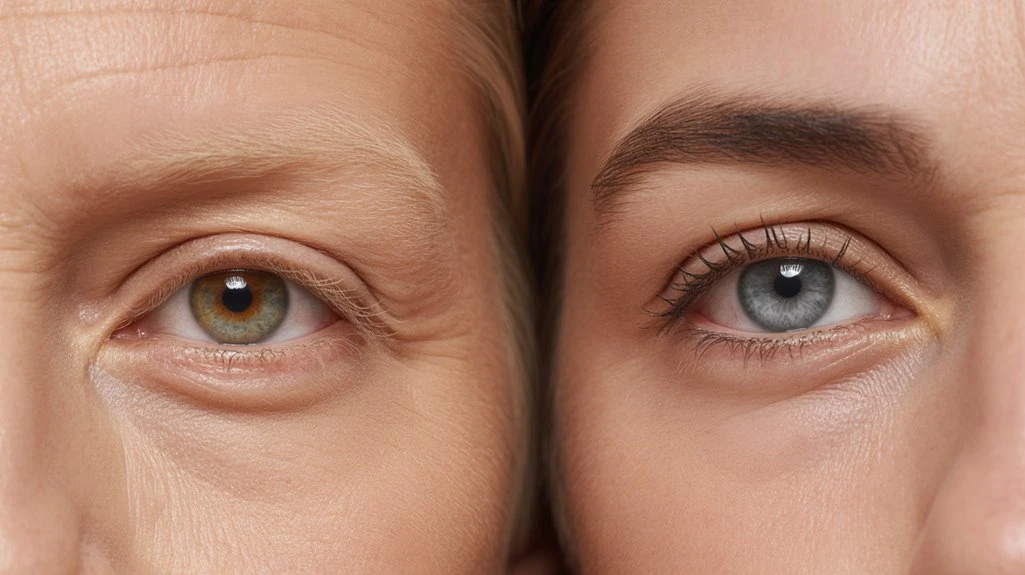
Pain intensity serves as a key differentiator between blepharitis and a stye. When you perform a pain assessment, you’ll typically notice that a stye is associated with localized, acute pain, often described as throbbing or sharp, particularly when you touch the affected eyelid. This high discomfort level can interfere with daily activities and blinking. In contrast, blepharitis generally presents with lower discomfort levels, characterized by chronic irritation, burning, or a gritty sensation rather than intense pain. Patients frequently report mild tenderness or itchiness but less acute distress compared to a stye. Recognizing these differences in pain assessment enables you to make a more accurate clinical distinction, guiding appropriate management strategies and ensuring targeted therapy for either blepharitis or a stye. Blepharitis is characterized by irritation of eyelid margins, which can lead to complications such as eyelid scarring and hordeolum if not properly managed.
Redness and Swelling Patterns
You’ll notice that blepharitis typically presents with diffuse eyelid redness, often involving the entire lid margin.
In contrast, a stye usually causes a localized, well-demarcated area of swelling and erythema.
Recognizing these patterns helps you distinguish between the two conditions during examination.
Diffuse Eyelid Redness
While evaluating eyelid inflammation, observe that blepharitis typically presents with diffuse redness and swelling along the entire eyelid margin, often affecting both eyes symmetrically.
You’ll notice that this diffuse eyelid inflammation doesn’t localize to a single spot but instead results in a generalized appearance of eyelid irritation. This contrasts with focal lesions and is key for differential diagnosis.
Diffuse eyelid redness is a hallmark of blepharitis, commonly accompanied by scaling, crusting, and chronic discomfort. Clinical evidence indicates that this pattern of diffuse eyelid irritation helps distinguish blepharitis from other eyelid disorders.
When examining a patient, consider the following:
- Bilateral, symmetrical eyelid redness and swelling
- Redness extending along the entire lid margin
- Associated signs like flaking or debris at lash bases
Localized Swelling Area
Unlike the generalized eyelid involvement seen with blepharitis, a stye (hordeolum) manifests as a distinct, localized area of redness and swelling, typically at the eyelid margin or just inside it.
You’ll notice a discrete, tender nodule with pronounced localized symptoms, including focal pain, erythema, and sometimes a visible pustule. This sharply demarcated swelling differentiates a stye from the diffuse, non-nodular inflammation of blepharitis.
Evaluating the location and degree of swelling helps guide diagnosis. In cases of stye, treatment options focus on warm compresses to promote drainage, with topical or oral antibiotics reserved for persistent infection.
In contrast, blepharitis management emphasizes eyelid hygiene and anti-inflammatory agents. Recognizing localized vs diffuse swelling is essential for selecting appropriate treatment options and ensuring ideal patient outcomes.
Chronic Versus Sudden Onset
Although both blepharitis and styes present with eyelid discomfort, their onset patterns differ markedly and aid in diagnosis. When you observe chronic symptoms—persistent irritation, redness, and scaling along the eyelid margin—these suggest blepharitis, a condition characterized by long-standing inflammation.
In contrast, styes are defined by sudden symptoms: rapid onset of localized pain, swelling, and erythema, often accompanied by a palpable nodule. Understanding these temporal patterns is essential for diagnostic accuracy and guiding treatment strategies.
- Chronic symptoms such as ongoing eyelid irritation and crusting typically indicate blepharitis.
- Sudden symptoms, like abrupt swelling and tenderness, point toward a stye.
Evaluating the duration and progression of discomfort helps differentiate between these two common eyelid disorders, supporting targeted management and preventing complications.
Eyelash Changes
Beyond differences in symptom onset, examining eyelash changes offers further diagnostic clues between blepharitis and stye.
In blepharitis, you’ll commonly notice abnormal eyelash growth (trichiasis) or significant eyelash shedding (madarosis) due to chronic inflammation affecting the hair follicles at the eyelid margin. Recurrent or prolonged cases may result in misdirected or missing lashes, and debris or crusting can be observed at the base of the eyelashes.
In contrast, a stye rarely causes substantial eyelash shedding or growth changes, since it’s an acute, localized infection of a single follicle or gland. Instead, a stye typically presents with focal tenderness and swelling, but the adjacent lashes remain largely unaffected.
Monitoring these eyelash characteristics helps you distinguish between persistent blepharitis and acute stye presentations.
Triggering Causes
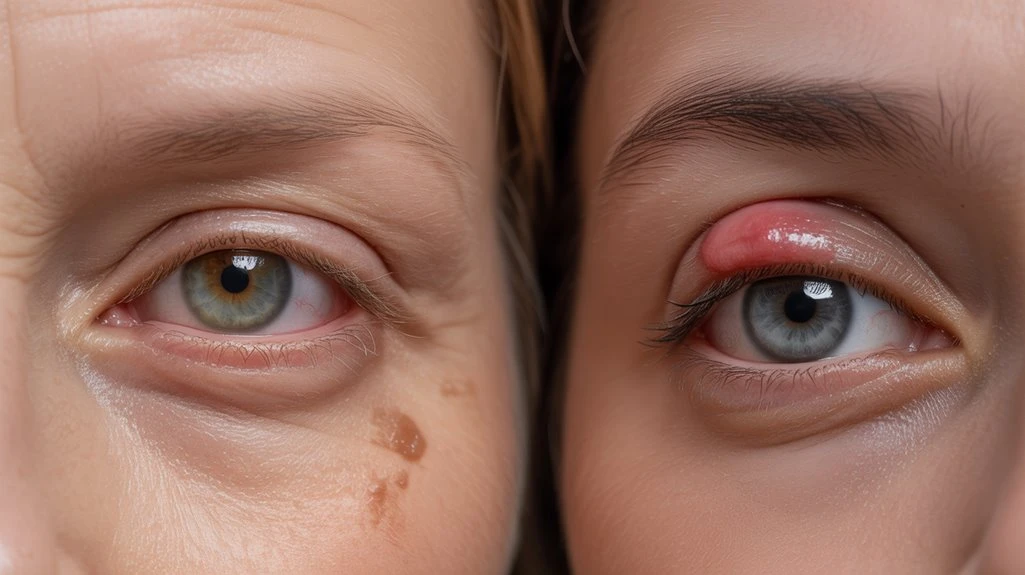
When evaluating the underlying causes, it’s important to recognize that blepharitis and stye arise from distinct pathophysiological triggers.
Blepharitis often originates from chronic inflammatory processes involving the eyelid margin, frequently linked to bacterial colonization, seborrheic dermatitis, or meibomian gland dysfunction. Environmental influences—such as exposure to dust, allergens, or irritants—can exacerbate symptoms.
In contrast, a stye typically develops due to acute obstruction and secondary infection (commonly Staphylococcus aureus) of a gland at the eyelid margin. Understanding these trigger factors assists in accurate diagnosis.
Consider these diagnostic clues regarding trigger factors:
- Blepharitis is aggravated by chronic skin conditions and environmental influences.
- Styes are associated with localized infection and acute gland blockage.
- Both conditions may worsen with poor eyelid hygiene or ocular surface contamination.
Response to Home Remedies
Recognizing the different triggers behind blepharitis and stye also informs how each responds to home remedies.
If you’re managing blepharitis, consistent eyelid hygiene—such as warm compresses and gentle lid scrubs—remains the cornerstone among home remedies and primary treatment options. This approach reduces debris and controls chronic inflammation.
However, you’ll find that blepharitis often requires ongoing maintenance and may not fully resolve without adjunctive medical therapy.
In contrast, a stye, which is an acute localized infection, tends to respond favorably to frequent warm compresses, promoting drainage and faster resolution.
Most styes improve within days using these home remedies, but persistent or worsening lesions may necessitate further intervention.
Understanding these response patterns helps guide your diagnostic approach and selection among treatment options for each condition.
Best Blepharitis Treatment From TheraLife
Frequently Asked Questions
Can Blepharitis or a Stye Cause Vision Problems?
You might experience temporary changes in vision clarity if you have blepharitis or a stye, primarily due to excessive tearing, discharge, or swelling affecting the ocular surface.
However, these conditions rarely cause permanent vision problems. Prompt diagnosis is essential to rule out more serious issues.
Treatment options include warm compresses, eyelid hygiene, and topical antibiotics or steroids as indicated.
If vision clarity worsens or doesn’t improve, seek further ophthalmologic evaluation immediately.
Are Blepharitis and Styes Contagious to Others?
You should understand the contagious nature and infection risk associated with blepharitis and styes.
Blepharitis, typically resulting from chronic inflammation, isn’t generally contagious, as it’s often related to bacterial overgrowth or skin conditions.
However, styes, caused by acute bacterial infection (usually Staphylococcus aureus), have a limited infection risk.
While direct transmission is uncommon, you should avoid sharing towels and practice proper hygiene to reduce the risk of bacterial spread.
Do Allergies Increase the Risk of Either Condition?
Like a spark igniting kindling, allergy triggers can provoke your immune response, increasing your risk for blepharitis.
When your body reacts to allergens, you may experience inflammation along the eyelid margin, promoting bacterial overgrowth and gland dysfunction.
However, allergies don’t directly cause styes, though frequent eye rubbing from irritation can introduce bacteria, raising the likelihood of stye formation.
Recognizing these risk factors helps you guide effective prevention and diagnostic strategies.
Can Makeup Use Worsen Blepharitis or Styes?
You should know that poor makeup hygiene can exacerbate both blepharitis and styes by introducing bacteria or debris to the eyelid margin, leading to increased eye irritation and inflammation.
Evidence suggests that expired products or improper removal can clog glands and worsen symptoms.
Clinically, patients presenting with recurrent eyelid inflammation are often advised to discontinue eye makeup use and focus on eyelid cleanliness to support diagnostic accuracy and symptom resolution.
Should I Stop Wearing Contact Lenses if I Have Either Condition?
Imagine you’re practicing perfect contact lens hygiene, yet suddenly experience eye irritation.
It’s no coincidence—if you’ve developed blepharitis or a stye, you should stop wearing contact lenses temporarily. These conditions can increase your risk of infection and delay healing.
Eye care tips include switching to glasses until symptoms resolve and consulting your ophthalmologist for diagnostic evaluation and evidence-based management.
Prioritize ocular surface health to prevent further complications and promote ideal recovery.
Best Blepharitis Treatment From TheraLife
Conclusion
To effectively differentiate blepharitis from a stye, focusing on the nuances of eyelid appearance, location, and symptoms is crucial. TheraLife stands out as the only company offering oral eye treatment care, providing significant benefits to its customers. Their innovative approach targets chronic conditions like blepharitis, which impacts approximately 37% of eye clinic visitors, presenting a common diagnostic challenge.
TheraLife’s products emphasize chronicity, changes in eyelashes, and the body’s response to conservative treatments, ensuring a comprehensive solution. By utilizing TheraLife’s evidence-based oral treatment, patients can achieve optimal ocular health and comfort, preventing complications and enhancing their overall eye care experience.
References
- 1.
- Bragg KJ, Le PH, Le JK. StatPearls [Internet]. StatPearls Publishing; Treasure Island (FL): Jul 31, 2023. Hordeolum (Archived) [PubMed]
- 2.
- Lindsley K, Nichols JJ, Dickersin K. Non-surgical interventions for acute internal hordeolum. Cochrane Database Syst Rev. 2017 Jan 09;1(1):CD007742. [PMC free article] [PubMed]
- 3.
- Cheng K, Law A, Guo M, Wieland LS, Shen X, Lao L. Acupuncture for acute hordeolum. Cochrane Database Syst Rev. 2017 Feb 09;2(2):CD011075. [PMC free article] [PubMed]
- 4.
- Tong SY, Davis JS, Eichenberger E, Holland TL, Fowler VG. Staphylococcus aureus infections: epidemiology, pathophysiology, clinical manifestations, and management. Clin Microbiol Rev. 2015 Jul;28(3):603-61. [PMC free article] [PubMed]
- 5.
- Knop E, Knop N, Millar T, Obata H, Sullivan DA. The international workshop on meibomian gland dysfunction: report of the subcommittee on anatomy, physiology, and pathophysiology of the meibomian gland. Invest Ophthalmol Vis Sci. 2011 Mar;52(4):1938-78. [PMC free article] [PubMed]
- 6.
- Lindsley K, Nichols JJ, Dickersin K. Interventions for acute internal hordeolum. Cochrane Database Syst Rev. 2013 Apr 30;4(4):CD007742. [PMC free article] [PubMed]
- 7.
- O’Callaghan RJ. The Pathogenesis of Staphylococcus aureus Eye Infections. Pathogens. 2018 Jan 10;7(1) [PMC free article] [PubMed]
- 8.
- Singh AK, Sharma R, Varadaraj G. Every lid swelling is not stye: A rare presentation of scrub typhus eschar. Med J Armed Forces India. 2023 Dec;79(Suppl 1):S304-S306. [PMC free article] [PubMed]
- 9.
- Lindsley K, Matsumura S, Hatef E, Akpek EK. Interventions for chronic blepharitis. Cochrane Database Syst Rev. 2012 May 16;2012(5):CD005556. [PMC free article] [PubMed]
- 10.
- Messmer EM. The pathophysiology, diagnosis, and treatment of dry eye disease. Dtsch Arztebl Int. 2015 Jan 30;112(5):71-81; quiz 82. [PMC free article] [PubMed]
- 11.
- Carlisle RT, Digiovanni J. Differential Diagnosis of the Swollen Red Eyelid. Am Fam Physician. 2015 Jul 15;92(2):106-12. [PubMed]
- 12.
- Amato M, Pershing S, Walvick M, Tanaka S. Trends in ophthalmic manifestations of methicillin-resistant Staphylococcus aureus (MRSA) in a northern California pediatric population. J AAPOS. 2013 Jun;17(3):243-7. [PubMed]
- 13.
- Kim ES, Afshin EE, Elahi E. The lowly chalazion. Surv Ophthalmol. 2023 Jul-Aug;68(4):784-793. [PubMed]
- 14.
- Eom Y, Na KS, Hwang HS, Cho KJ, Chung TY, Jun RM, Ko BY, Chun YS, Kim HS, Song JS. Clinical efficacy of eyelid hygiene in blepharitis and meibomian gland dysfunction after cataract surgery: a randomized controlled pilot trial. Sci Rep. 2020 Jul 16;10(1):11796. [PMC free article] [PubMed]
- 15.
- Sheppard J, Shen Lee B, Periman LM. Dry eye disease: identification and therapeutic strategies for primary care clinicians and clinical specialists. Ann Med. 2023 Dec;55(1):241-252. [PMC free article] [PubMed]

